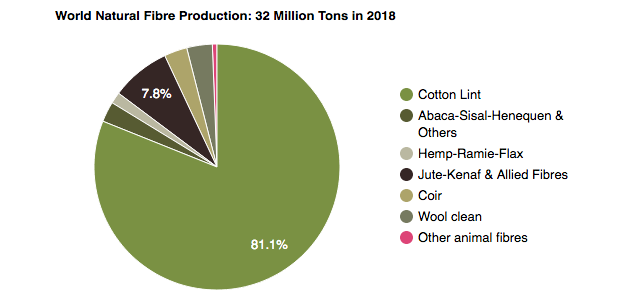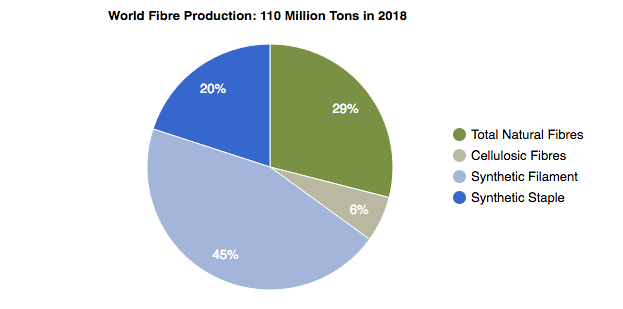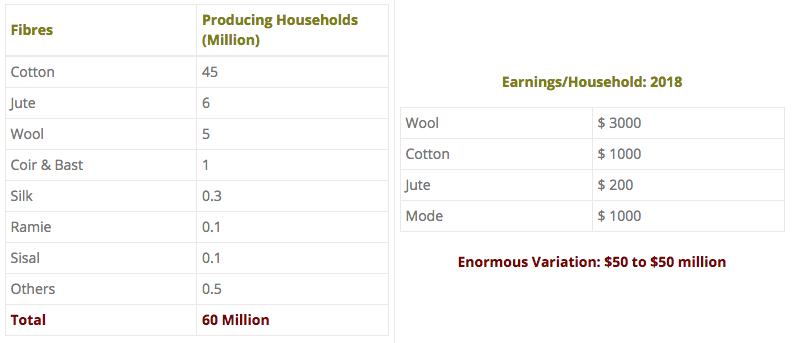World natural fibre production in 2018 is estimated at 32 million metric tons. DNFI, in cooperation with the Food and Agriculture Organization of the United Nations (FAO), collects statistics on 14 categories of natural fibres, ranging from Abaca to Wool and Other Animal Fibres. During the past decade, world natural fibre production has ranged between 28 million tons and 35 million tons, with most of the year-to-year variation caused by changes in yields linked to weather.

Cotton accounted for 81% of natural fibre production by weight in 2018, Jute accounted for 7%, while Coir and Wool each accounted for 3%.
The farm value of world natural fibre production in 2018 is estimated at $60 billion, up from $40 billion in 2016 and 2017. Cotton accounted for two-thirds of natural fibre production by value, and wool accounted for one-fourth. Prices of cotton have been above average in recent years as the Government of China has withheld supplies from the market through the operation of a State Reserve. Prices of wool were record high in 2018 caused by declining sheep numbers linked to drought in the Southern Hemisphere.
World production of all apparel and textile fibres reached 110 million tons in 2018, and natural fibres accounted for 29% of the total, down from 41% in 2008. Cellulosic fibre production accounted for 6% of the total in 2018, synthetic filament accounted for 45%, and synthetic staple 20%. The synthetic fibers are dominated by polyester, which accounts for nearly 90% of world filament production and 70% of world synthetic staple production. The remaining synthetic fibres are composed mostly of nylon, acrylic and polypropylene.

The decline in the share of natural fibres in total fibre production in the last decade is the result of exponential growth in polyester production. Between 2008 and 2018, synthetic filament production (used primarily in fast-fashion apparel) nearly doubled, rising from 26 million tons to 50 million. Over the same period, synthetic staple production rose from 15 million tons to 22 million, and natural fibre production rose just from 31 million tons to 32 million.
Employment in natural fibre industries is difficult to estimate because households may be engaged in production one year but not the next, households vary in size, not everyone in a household may be engaged in production, and because many governments maintain employment statistics for the agricultural sector as a whole, but not for individual agricultural products. DNFI estimates that about 60 million households worldwide are engaged in natural fibre production, and that total employment, including both full-time year-round employment and part time or seasonal employment, is around 300 million, which represents about 4% of the world’s population.

Earnings per household vary substantially across industries and regions. A small holder in Bangladesh may earn the cash equivalent of $50 per year from jute production, in addition to the production of food crops and animal products in an integrated farming system. In contrast, a large mechanized cotton farm in Brazil or wool operation in Australia might gross $50 million a year. The mode for household earnings from natural fibre production is $1,000 in gross revenue per year.
Natural fibres are grown commercially in almost all countries, and about 150 countries are involved in exports or imports of natural fibres. Natural fibres connect people to markets because they are storable, durable, they have high ratios of value to the cost of transportation, and because many natural fibres can be produced, either in arid regions, like cotton and wool, or in extremely wet regions, like jute in India and Bangladesh.
In many producing regions, natural fibres are the only viable economic activities available, providing incomes to millions. Income from fibre production can be used to pay school fees and health costs or to purchase food. Natural fibres are almost always grown in rotation with food crops or they provide food as by-products. As cash products, natural fibres often serve as collateral against input loans to farmers in developing countries, allowing farmers access to fertilizer, insecticides and seeds for food crops that would otherwise be unavailable. Consequently, production of food rises in areas where natural fibres are grown.
Download report: Natural Fibres and the World Economy – July 2019
Author
Terry Townsend
Source
DNFI, press release, 2019-08-08.
Supplier
DNFI Discover Natural Fibres Initiative
Food and Agriculture Organization of the United Nations (FAO)
Share
Renewable Carbon News – Daily Newsletter
Subscribe to our daily email newsletter – the world's leading newsletter on renewable materials and chemicals













